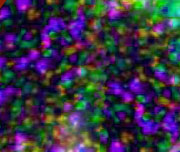Films of all types exhibit grain, a speckled appearance visible when images are examined closely and at high magnification. Slow films, typically slower than about ISO 200, are noticeably less grainy than faster films. Black-and-white films having speeds of ISO 800, 1600 or 3200 are particularly grainy and may be used by photographers wanting to make grain a feature of their images. The coarse gritty realism they produce can be very attractive when used creatively.
 Grain is controlled to a large extent by film speed (emulsion), exposure settings and darkroom processes. Faster films obtain their increased sensitivity partly by having larger grains of light-sensitive silver halide in their emulsions. Hence, in broad terms, the faster the film the grainier the images appear. This might seem to be a disadvantage of film as a recording medium, but digital sensors produce a roughly equivalent although generally less attractive noise component as ISO rating is increased.
Grain is controlled to a large extent by film speed (emulsion), exposure settings and darkroom processes. Faster films obtain their increased sensitivity partly by having larger grains of light-sensitive silver halide in their emulsions. Hence, in broad terms, the faster the film the grainier the images appear. This might seem to be a disadvantage of film as a recording medium, but digital sensors produce a roughly equivalent although generally less attractive noise component as ISO rating is increased.
Film-based images consist of randomly sized and scattered granular clouds of dyes. The grains are often much smaller than the smallest of digital pixels which are incidentally also arranged in predictable regular patterns. The effect produced in an image is therefore subtly different in the two media. The random nature of grain also has significant advantages in terms of aliasing with patterned materials.
The dynamic range characteristics of film are intimately related to grain size and distribution in the emulsion. Indeed, dynamic range is proportional to the ratio of the largest grain size to the smallest. The subtlety of shading produced by an emulsion is dependent upon the variance of grain size and distribution. Ten thousand different grain sizes imply a similar number of potential represented tones.
A final factor related to grain is known as stochastic noise. Our brains are very good at filtering out random noise or unwanted detail in a scene, and concentrating on the principal elements. This process is more effective when the grain is randomly sized and distributed as in the case of film. Indeed film grain enhances the ability of the brain to see subtle shading, a process known as stochastic resonance.






